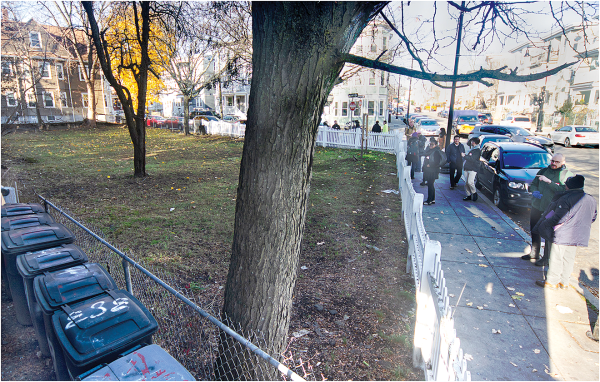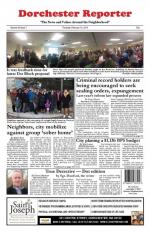December 6, 2023

This lot at 379 Geneva Ave. has been vacant since at least the 1970s. Chris Lovett photo
Like its surrounding neighborhood, the vacant lot at 379 Geneva Ave. stands at a crossroads. Located at the corner of Corona Street and fringed with a white picket fence, the lot’s 7,647 square feet have been—apart from a handful of trees—vacant since at least the 1970s.
On city atlases from a few decades earlier, the parcel shows up as a plus-sized yard wrapped around the outline of a three-family house, or “three-decker.” Under a project of the Mayor’s Office of Housing and the Boston Society for Architecture (BSA), the city will attempt to reconfigure that familiar imprint of Dorchester’s past as a prototype for infill housing of the future.
The city moved to foreclose on the property for unpaid taxes in 1977, finally took possession in 1989, and added it to a current inventory of more than 1,000 vacant parcels owned by the Mayor’s Office of Housing and the Boston Planning and Development Agency (BPDA).
Last month, the Mayor’s Housing Innovation Lab issued a request for proposals (RFP) for the lot and another vacant parcel on River Street and Marcy Road, near Mattapan Square. The aim is for developers to partner with the city in “co-creating Boston’s Future-Decker,” with new possibilities for design, materials, and construction.
More than a century after the emergence of the “three-decker” as the city’s main source of working-class housing, the city’s RFP envisions a new version for the “forgotten middle,” defined as “those who don’t qualify for subsidized housing but are unable to afford market-rate prices.” As to annual household income, their range would be from $110,650 to $138,300.
The RFP is aiming for 6-15 units at both locations, with a preference for home ownership, whether of individual units or multiple units in a building. Developers who place a lower cap on household income could be eligible for subsidies from the city.
In line with “community vision,” the RFP calls for proposals that honor the context of both locations, while promoting mixed-income housing. Other goals are to curb carbon emissions, and to increase safety and vibrancy, by promoting travel by foot, bike, and transit.
Unlike the earlier three-deckers that featured uniform floor plans on each level, the “future-deckers” could have layouts with more diversity and flexibility. Like the needs of its households, the building could change over time.
“We want to follow the context, but imagine an alternative to that,” said Wandy Pasçoal, a housing innovation designer for the BSA, during a networking session and site visit on Geneva Avenue last Friday.
Pasçoal said conversations with neighbors helped envision housing not just as a building, but as an experience: living with families, building wealth, the sense of the neighborhood as a home.
“There’s a lot we can learn from what’s been done before,” she added, “and what we can do.”
Proposals have to be filed with the city by next Feb. 14. According to a count from the Housing Innovation Lab, last week’s site visits drew 31 people, mostly architects and developers. Among those looking on was James Sullivan, who runs a firm based in West Roxbury.
“This project is an opportunity to develop my own housing design skill to the next level,” he said in an interview later, “given the limitations of the lot, the sizes, the neighborhood as well.”
As outlined in the RFP, use of the new housing prototype could extend to locations beyond the city’s inventory: “While development proposals created as a result of this RFP will be constructed on city-owned land, our intention is to spur creative thinking to develop a housing model that can be constructed efficiently and cost effectively on privately owned sites across the city.”
“If you can invent a constructability or a profitable way for contractors to build these things within these sites,” said Sullivan, “I think we have to look at that.”
The Geneva Avenue lot is five blocks from the Fields Corner MBTA station. Over the last 15 years, the nonprofit developer VietAID has added transit-oriented housing in the same area, including Bloomfield Gardens, a four-story building with 27 apartments at the corner of Geneva Avenue and Tonawanda Street — the former site of Bloomfield Hall, which was destroyed by a fire in 1972. Built in 2012, Bloomfield Gardens is listed as a project by Davis Square Architects, and as “a perfect smart growth development for the City of Boston.”
Along the Geneva Avenue corridor between Park Street and Bowdoin Street, the visual context is characterized by mixed use, but still dominated by three-deckers, as well as chain-link fences through which a passerby can be tracked by the wary eyes of a pit bull. The area has long been shadowed by gun violence, most recently with a fatal shooting on Corona Street that happened at around two o’clock in the afternoon on Friday, Oct. 13.
On Corona Street, cars parked on both sides often straddle the sidewalk, barely leaving enough space for one-way traffic. But the RFP calls for “only using the minimum parking necessary to allow new uses to flourish and calm existing traffic.” On the Geneva Avenue parcel, room for off-street parking could be further limited by a need to preserve mature trees, which can enhance curb appeal and reduce the “heat island” effect.
The RFP includes one more parking caveat: “Many homes surrounding these sites have limited access to off-street parking, so there is greater demand for on-street parking in these areas. Applicants must take these factors into consideration in determining the amount of open space and parking ratios associated with each building.” And neighborhood concerns about parking go back at least as far as 2008, at meetings on the plans for Bloomfield Gardens, just three blocks away.
A 39-year-old lifelong neighborhood resident, Leroy Wallace, calls the parking on Corona Street “horrible.” Wallace maps the neighborhood by pointing at the houses, identifying them by people he knows, or by communities outside Boston that are home to investor landlords. Currently renovating his property on the other side of Corona Street, Wallace said the vacant parcel should be developed with no more than 9 units in order to leave enough room for trash containers and a driveway for off-street parking.
A neighbor of the vacant parcel who also lives on the other side of Corona Street, Marlene Aleyne, complained about people using the space for cookouts and drinking, as well as for a dumping ground for empty bottles and dog waste.
A 70-year-old native of Barbados who has lived next to the lot for almost 36 years, Aleyne told city officials and participants at the site visit: “I’m pleading with you, kindly: please put a house here.”
According to a commercial website, rents in the same area near Fields Corner spread across a wide range, with some exceeding the fair market price covered by Section 8 subsidies—slightly more than $3,000 a month for three bedrooms. And, as Sullivan acknowledged, the current market for the three-decker is not far removed from the last century’s, dominated as it is by working-class families, many of them recent immigrants
“I’ve grown to love them because they make a lot of sense,” said Sullivan. “And they provided a solution to housing for people that were new to this country, that were up and coming in this country— and they could afford it. But I don’t know about now. I mean, it’s just crazy. That kind of opportunity, that American ideal of working hard and owning a house, it doesn’t seem to be attainable anymore.”



